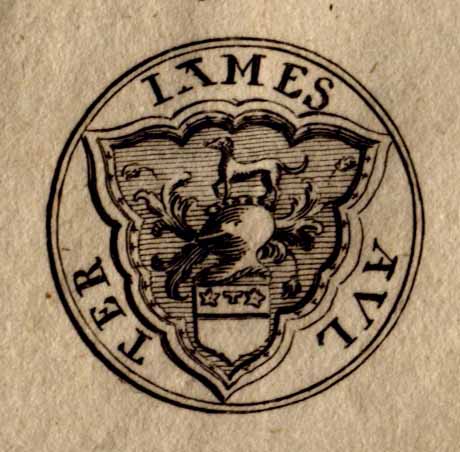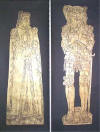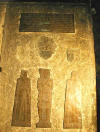Sir William DRURY of Hawstead
Born: BEF 1500, Hawstead, Suffolk,
England
Died: 11
Jan 1557/8
Buried: Church of Hawstead, Suffolk, England
Father: Robert DRURY of
Hawstead (Sir)
Mother: Anne CALTHORPE
Married 1: Joan St. MAUR
BEF 7 Feb 1515/6
Married 2: Elizabeth
SOOTHILL (b. ABT 1505 - d. 19 May 1575) (dau. of and co-heir Henry Soothill
and Joan Empson) ABT
1535, Suffolk, England
Children:
1.
Elizabeth DRURY
2. Mary DRURY
2.
Robert DRURY of Hawstead
4. Henry DRURY of Lawshall
5. Anne DRURY
6.
Dorothy DRURY
7. Frances DRURY
8. Bridget DRURY
The details in this biography come from the
History of Parliament, a
biographical dictionary of Members of the House of Commons.
Born by 1499, first son of Sir Robert Drury
of Hawstead by his first wife.
Educ. ?Eton; ?King's, Camb. 1511; Lincoln's Inn, adm. 12 Feb 1517.
Married firstly, by
7 Feb 1516, Joan, dau. of William St. Maur,
who died in childbirth; and secondly,
BET Aug 1518 /
Feb 1521, Elizabeth,
dau. of Henry Sothill of Stockerston Leics.,
by whom he had four sons and nine daughters. Kntd. 30 May.
Succceded family 2 Mar 1535.
J.p. Suff. 1529-d., q. 1554; ?esquire
extraordinary of the body by 1533; sheriff, Norf. and Suff. 1536-7, 1544-5;
commr. benevolence, Suff. 1544/45, relief 1550; other commissions 1534-d.; PC by
1 Nov 1553.
Until the accession of Mary
Sir William
Drury shared in the normal duties of a local magnate while appearing at court on
important state occasions. In the autumn of 1536 he and his
brother
Sir
Robert assisted
Thomas Howard, 3rd Duke of
Norfolk in quelling the northern rebellion called
the Pilgrimage of
the Grace,
and he was called upon for similar action in 1539 when appointed a commissioner
to search and defend the Suffolk coast, and again in 1542 when named by the
King
as one of those whom Norfolk should take on his expedition to protect the Scottish
borders in Sep. During his second term as sheriff of Norfolk and Suffolk he returned
his nephew Sir William Waldegrave to the Parliament of 1545. Drury's post in the
Household, even if he held it until the death of
Henry VIII, was not renewed under
Edward VI, but he was sufficiently in favour with the Council of the time to be
recommended as knight of the shire for Suffolk in the spring of 1553.
Drury and his fellow-Member Sir Henry Bedingfield, likewise a Council
nominee, were included in Cecil's list of gentlemen who were expected to
transact 'affairs for Queen Jane', but in the event both rallied to
Mary. He was
the second person sent for by Princess Mary in
Jul 1553 when she heard the
news of her brother, Edward VI's death.
Drury
swore allegiance on 17 Jul. Mary ordered all captains to bring their men to muster under
Sir William Drury and Sir William Waldegrave. William took 100 men to
Kenninghall to assist Mary, who was proclaimed Queen. He became a Privy Councillor some time in the
autumn and was one of those charged to survey the ordnance and stores. He was
not given office, but under new administrative arrangements in Feb 1554 he was
appointed with Sir Robert Rochester and
Sir Thomas Cornwallis to order victuals
for Calais and Berwick. His position gave him a lien on one of the Suffolk seats
and in each of his remaining four Parliaments his partner, who took the junior
place in all save the last of them, was his kinsman
Sir Henry Jerningham. There
are only two references to Drury in the Journal, one to a privilege case in Oct
1553 concerning one of his servants, and the other to the unsuccessful bill for
distresses and replevins committed on its second reading in Apr 1554 to him and
John Mawdley.
| A key player in Queen
Mary's bid to restore Catholicism in England, Sir William Drury was ordered
to search the house of Thomas Pooley of Icklingham who was leading a
Protestant revolt against the Queen's proposed marriage to
King Felipe of
Spain. Sir William had been previously appointed in 1552 as a commissioner
of Suffolk to investigate the question of pensions for dispossesed members
of religious houses during the previous reign. Drury augmented his inheritance of seven
Suffolk manors by grant, marriage and purchase. Two of his acquisitions,
Lawshall and Whepstead, Suffolk, were confirmed to him by Mary to hold in chief
on his surrender of an annuity of 100 marks
awarded him in Nov 1553 for his services during the succession crisis.
Sir William had six daugthers, including
Anne who married Sir
Christopher
Heydon of Baconsthorpe,
who would later serve as a magistrate in the recuscancy trial of her fourth
cousin, John Drury of Godwick. Another dau. was Elizabeth who married
Sir Robert Drury of Rougham, her fourth cousin twice removed.
By
his will of 6 Dec 1557 his wife and executrix was to have specified lands and
rents for ten to 13 years towards the
performance of the will and testament. Provision for other members of his family
included £200 towards the marriage of his dau. Dorothy. Sir William's son,
Robert Drury of Hawstead, died two days before the making
of the will
and the estate passed to Robert's son,
William Drury, aged seven.
Richard Rich,
1st Baron Rich, the young William Drury's maternal grandfather, was appointed
supervisor of the will. He hosted Queen
Elizabeth at Hawstead Place during her Progress of Suffolk in
1578. His uncle, Henry Drury (the second son of Sir William, and brother of
Robert) lived at Lawshall Manor where he was arrested that same day by
Elizabeth.
|

The seal of Sir William Drury of Hawstead, with the
Tau Cross and greyhound crest.
|
Sir William died on 11 Jan 1558. The inscription on his
monument in
Hawstead church says of him:
|

Brass rubbings of Sir William and his first wife,
Joan |
Whilst he lived here was loved of every
wight.
Such temperance he did retain, such
courtesy,
Such noble mind with justice joined, such
liberality,
As fame itself shall sound for me the glory
of his name. |

Brasses inlaid atop the tomb of Sir William Drury, with his
wives Joan St. Maur, left, and Elizabeth Sotehill, right |






